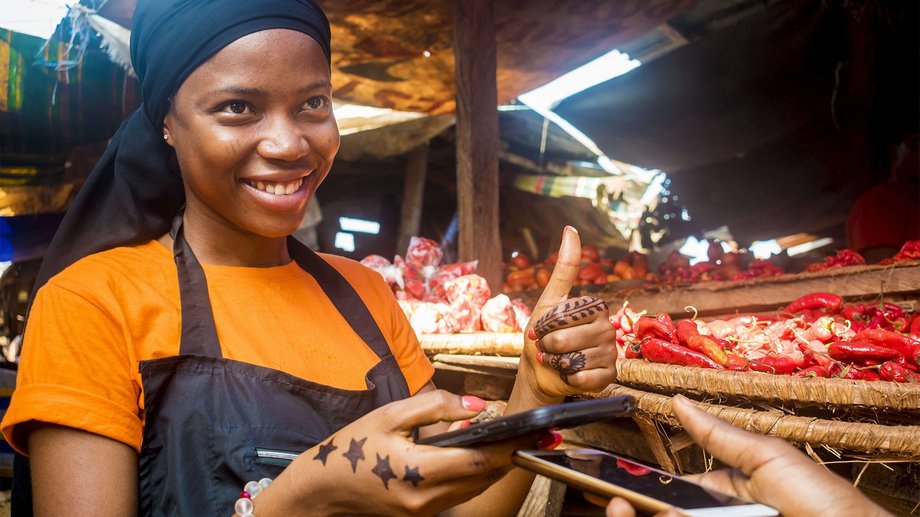An estimated one in five people globally have no direct engagement with the financial system. The exclusion from financial services comes at a price. It limits their opportunity to borrow at competitive rates, to protect their money and save securely, and to receive and send funds, making it a gating factor for much personal and economic advancement.

CBDC: a way to drive digital and financial inclusion
One of the core motivations for CBDCs in emerging markets is to extend access to financial services to every citizen. But leveling that playing field is only going to be possible if CBDCs are designed for inclusivity from the outset.
The global distribution of that 1.7 billion unbanked population is far from even.1 The majority live in emerging market economies, although not exclusively. The US Federal Reserve reckons that 5% of US adults are unbanked and 13% are underbanked.2 In Romania, 42% of the population is unbanked,3 while in Vietnam and the Philippines, over two-thirds of people don’t have access to a bank account.4
For various reasons, women in almost all of these settings are also more likely to experience higher levels of financial exclusion. In fact, the World Bank calculates that in low- and middle-income economies, women are, on average, nine percentage points less likely than men to have a bank account – a gender gap that has stubbornly persisted.5
Challenging the digital divide
What has emerged in recent years is the potential for that divide to become even wider. With the rise of digital business models, e-commerce, and electronic payment methods, the ability to engage in digital transactions is increasingly becoming a prerequisite for participation in many aspects of society, yet 37% of the world does not use the internet.6 There is a growing concern that individuals without a bank account will be locked out of more and more areas of rapidly digitalizing economies as today’s digital payment offerings require a bank account – a lack of access to digital services that can leave them increasingly financially vulnerable.
That digital divide is far from being ignored by governments worldwide. Indeed, the vast majority of the world’s central banks are actively exploring the introduction of a central bank digital currency – effectively digital money as legal tender – in many cases seeing it as a unique opportunity to dramatically extend financial inclusion to all members of society.
Yet it’s not just a solution for those without bank accounts. Digital payments currently require contracts with a third-party provider, which may charge fees or use personal data. Third-party providers also demand a certain creditworthiness or that payees are a certain age. The restrictive nature excludes many members of society.

The rationales inspiring CBDCs
The motivation behind CBDC initiatives is largely influenced by local circumstances. In its 2020 survey of global central bank leaders, the Bank for International Settlements found that emerging market economies not only show a much stronger desire to issue a CBDC, but also put financial inclusion at the top of their priority list; in comparison, in advanced economies (where financial inclusion is often already high), the emphasis on financial inclusion is outweighed by a focus on payments safety and efficiency.7
“In many emerging market economies, CBDC is being viewed as one of the main tools to foster financial inclusion,” says Tanja Heßdörfer, Director Business Development CBDC at G+D, which is partnering with multiple central banks on CBDC initiatives worldwide. “So depending on how the CBDC solution is designed, it can provide a large part of a population with financial and digital services that they simply couldn’t access before.”
CBDCs are part of a broader wave of digital finance that has extended capabilities to many millions in recent years. But the commercial nature of these financial service offerings makes them far from universally accessible – or affordable. It’s a point well made recently by the Governor of the Bank of Ghana, which is developing the eCedi as a digital form of the national currency in partnership with G+D.8
Keynoting at the country’s Chartered Institute of Bankers in December 2021, Dr. Ernest Addison said, “There is no doubt that the private sector has spearheaded the recent surge in innovative financial digital solutions. … However, there is a limit to which private sector resources can be used to address the constraints to financial inclusion. For the digital economy to be truly inclusive, every eligible person must have access to some form of digital payment instrument, just like the physical currency.”9
Leveling the playing field
According to the UN’s research program Data2x, “women worldwide are less likely than men to have bank accounts and access to credit and loans. Closing the gender gap in financial inclusion would promote economic growth and resilience, reduce gender inequalities, enable more autonomy for women, and contribute positively to sustainable development.”10
“If designed in a truly inclusive manner, a CBDC could help to provide a level playing field for every citizen to have equal access to digital payments and financial services“
Director Business Development CBDC, G+D
Heßdörfer notes, “If designed in a truly inclusive manner, a CBDC could help to provide a level playing field for every citizen to have equal access to digital payments and financial services, as well as establishing their digital identity and creating a digital footprint. With women today having less access to such services, they stand to benefit to a greater degree.”
Financial inclusion driving economic growth
CBDCs could have a highly positive effect on the economic influence of women. “Being able to access financial services and establish their own financial identity enables women to more effectively grow wealth and lift themselves, their families, and their communities out of poverty, especially in developing markets,” says Erica Salinas, Global Program Manager for Digital Assets at Amazon Web Services, the cloud infrastructure company. “Women’s economic empowerment boosts national productivity, increases economic diversification and income equality, in addition to other positive outcomes. CBDCs, if properly designed for inclusivity, have the potential to enhance that.”
“Being able to access financial services and establish their own financial identity enables women to more effectively grow wealth and lift themselves, their families, and their communities out of poverty, especially in developing markets“
Global Program Manager for Digital Assets, Amazon Web Services
She puts that in a real-life context: “Many women within the unbanked population of emerging market economies are micro-entrepreneurs – for example, they run village stores, they’re seamstresses, and increasingly they’re remote skilled workers performing contract work for companies across the globe. It’s key to appreciate that they need financial services not only for personal expenses, but also for services to grow and finance their businesses and engage in the wider economy. Access to services that can help them buy assets, fund expansion, and receive payments can empower them to build wealth and, in many cases, lift themselves and their families out of poverty.” This can potentially be achieved through a CBDC-enabled digital financial footprint and the use of alternate risk-scoring methods.
Designing a CBDC for inclusion
“CBDC in itself is not a panacea for financial inclusion, but it could potentially provide cost-effective rails for services that increase financial inclusion,” argues Salinas. Success will very much be determined by the compelling nature of the wallets and other apps that deliver the financial services as well as associated digital and financial literacy campaigns, she says.
Traditional routes to financial services also have to be rethought, says Heßdörfer. “A CBDC cannot expect users to have access to a smartphone, to be tech-savvy or financially literate,” she explains. “Neither can merchants be expected to have access to high-end point-of-sale terminal devices or even internet connectivity. A truly inclusive CBDC needs to come with a very simple and intuitive user interface and involve zero or ultra-low transaction fees. It needs to be available through multiple low-cost formats, such as wristbands and smartcards, and accessible for offline payments.” Those are many of the fundamentals that G+D has built into its Filia® solution.
Digital cash for everyone, anywhere, anytime
Many of these design criteria are being implemented as part of the Bank of Ghana’s CBDC project. “The Bank of Ghana set the design criteria from the start to be highly inclusive, to serve the entire population by supporting financial inclusion. So, using its CBDC doesn’t require a bank account, a contract, or access to an expensive device,” says Heßdörfer. It also supports offline payment capabilities.
More and more central banks are following this path by investigating how a truly inclusive CBDC must be designed to serve all parts of society. Just recently, the Monetary Authority of Singapore hosted a global CBDC challenge.11 From over 300 submissions, G+D’s solution Filia® was chosen as a winner, being a means of payment that can be universally used and is truly inclusive, enabling participation in the digital economy even without a smartphone or a bank account.
The Central Bank of Brazil has also placed emphasis on accessibility and inclusion with regard to CBDC design. With the LIFT Challenge Digital Real, G+D submitted a proposal for a dual offline payment solution that can be used without power supply and even without access to the internet, network connectivity – or a bank account.12
As such commitments underline, CBDCs are being viewed as the key to narrowing the digital divide, opening up access to digital financial services to all, with women possibly the largest group who could be positively impacted. The key to making that a reality, though, will be the adoption of design approaches that can meet those challenges and deliver the compelling benefits – potentially bringing billions into the financial system.
-
Report on the Economic Well-Being of U.S. Households in 2020, Federal Reserve, 2021
-
The Countries Most Reliant on Cash in 2021, Merchant Machine, 2021
-
World Bank Data2x: Global Financial Inclusion Survey (Global Findex), Data2x, 2019
-
Measuring digital development, Facts and figures 2021, ITUPublications, 2021
-
FULL TEXT: BoG Governor’s address at CIB Annual Bankers Dinner, GhanaWeb, 2021
-
MAS Announces Winners of the Global CBDC Challenge, Monetary Authority of Singapore, 2021
-
G+D Filia® Digital Cash for Everyone, Anywhere, Anytime, YouTube, 2022
Published: 24/03/2022


